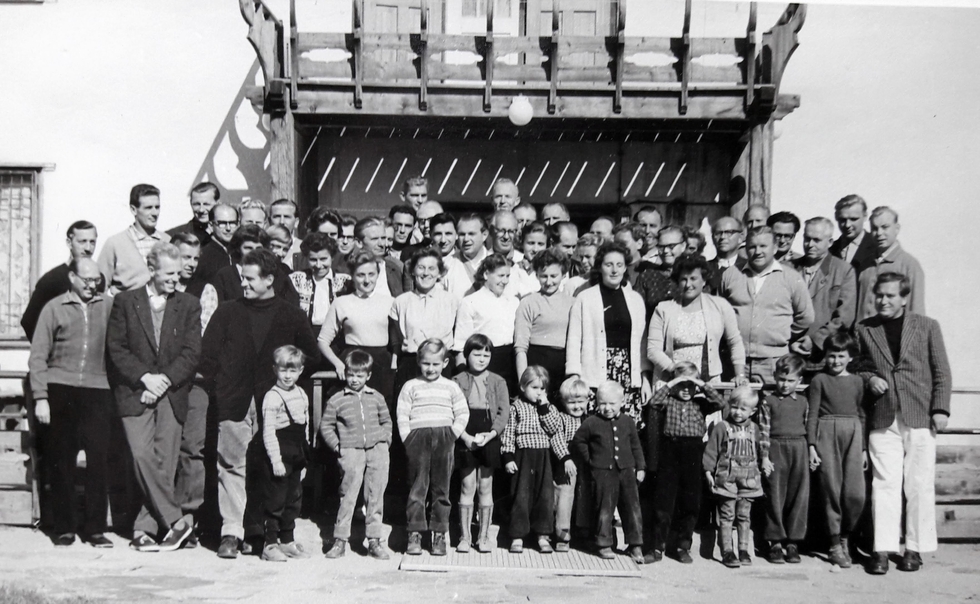With the ADGB Trade Union School in Bernau, Hannes Meyer was able to realize his ideal of how teaching and practice could be combined in construction. This included not only the involvement of Bauhaus students in the planning of the building ensemble, but also the employment of students in the building project itself. Konrad Püschel was one of them. In the spring/summer of 1929, he worked on the Bernau construction site as a trainee bricklayer and carpenter.
Püschel had begun his studies at the Bauhaus in Dessau in November 1926. After the compulsory preliminary course, he studied painting with Paul Klee and Wassily Kandinsky, followed by photography with László Moholy-Nagy. He also worked in Oskar Schlemmer's stage workshop. In 1927, he first started in the carpentry workshop under the direction of Marcel Breuer and finally in the architecture course of Hannes Meyer, who was to become his mentor for the coming years. Püschel worked together with his fellow students Philipp Tolziner, Béla Scheffler and Hubert Hoffmann, among others, on the first joint Bauhaus building project under Hannes Meyer, the construction of the Laubenganghäuser in Dessau. They analyzed the building site and the needs of the future residents of the arcade houses and took a decisive step towards social housing construction with this work.
When Hannes Meyer was awarded the contract to build the ADGB Trade Union School in Bernau-Waldfrieden, Püschel was also involved. During an internship of several weeks on the construction site, he built up an intimate relationship with the quiet wooded area and extended his time in Bernau. In a letter to his future wife Lieselotte, he raved about the idyllic location of the new school building: "Our building site is in the middle of the forest by a small lake. An hour away from the city. For me, it's the best summer retreat. The sun and the good forest air have given me a tan [...]." It would do him good to get rid of the "Bauhaus disease", Püschel wrote in another letter to his friend Walter Tralau. Püschel repeatedly emphasized how much he would learn on the Bernau construction site. This was one of the reasons why he finally decided to extend his internship into the summer: "I want to stay in Bernau for the summer, because the Bauhaus can't give me what I'm learning here in eight semesters. Here I can get in touch with construction first." In retrospect, Püschel was to write in his diary: "This summer I had a wonderful time at the Bauhaus, which refreshed and renewed me from the ground up. I wish every Bauhaus student such days."
The personal and pictorial description of the work on the construction site of the ADGB Trade Union School, as in Konrad Püschel's letters and his diary (both preserved in the archives of the Bauhaus Dessau Foundation), is unique. Although numerous memoirs of trade unionists who attended training courses in Bernau have been preserved, notes by Bauhaus students are a real rarity.
Together with Hannes Meyer and six other Bauhaus students from the architecture class (Philipp Tolziner, Béla Scheffler, Tibor Weiner, Réne Mensch, Klaus Meumann and Antonin Urban), Konrad Püschel's path first took him to Moscow in 1930/31. They called themselves the "Red Bauhaus Brigade" and lived together in a kind of small commune. As modernist architects, they wanted to gain a foothold in the Soviet Union, invited by Stalin to establish this new type of architecture with a focus on people. They worked on school buildings on behalf of the government, and only a few of them were actually built. After a vacation at home, Püschel and his Lieselotte returned to Moscow in 1932, where they married in 1933. When Stalin changed his mind in the mid-1930s and modern architects were now seen as the enemy, Hannes Meyer went back to Switzerland and finally to Mexico, while the Püschels returned to Germany. Some members of the Bauhaus brigade remained and did not survive their internment in the Gulag (such as Antonin Urban) or disappeared (such as Klaus Meumann).
During the Second World War, Püschel found employment with Alfred Arndt, a former Bauhaus student and later head of the finishing workshop at the Bauhaus when Hannes Meyer was director at the Bauhaus. Among other things, Püschel designed the home of the Bauhaus weaver Margaretha Reichardt in Erfurt, today's Margaretha Reichardt House. In 1940, he was drafted by the Wehrmacht and sent to North Africa and finally to the Eastern Front. After being imprisoned by the Soviets, he returned home in 1947, weighing only 40 kilograms.
And now he once again found help from one of his former Bauhaus fellow students. Gustav Hassenpflug, who taught as a professor of urban planning at the Hochschule für Architektur und Bauwesen (today's Bauhaus University Weimar), helped him obtain an assistant position. In 1960, Püschel founded the Faculty of Village Planning, which he headed until his retirement in 1972. Between 1955 and 1962, when the GDR promised North Korea help in rebuilding the cities of Hamhŭng and Hŭngnam, which had been destroyed by the Americans during the Korean War, Püschel became the main planner of the working group.
Throughout his life, Konrad Püschel remained closely connected to his time at the Bauhaus in Dessau. In the early 1970s, the GDR recognized numerous Bauhaus buildings as contemporary documents and designated them as monuments, including the ADGB Trade Union School and the Bauhaus in Dessau. What was only achieved with the renovation and partial reconstruction in Bernau in the early 2000s was already implemented in Dessau in the mid-1970s. The restoration of the former figurehead of modern architecture, the Bauhaus building designed by Walter Gropius himself, became a successful project under Konrad Püschel's leadership.



